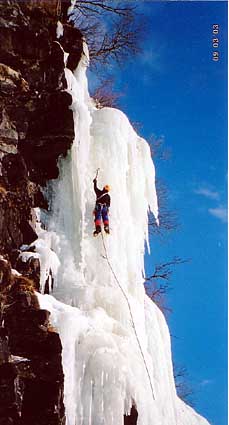|
K3-Hem -> Artiklar -> Arctic Ice by Rick McGregor Arctic Ice by Rick McGregor (rmcgregor@hotmail.com)
It had snowed most of the night, but by morning the snowfall had ceased. Our tracks from the day before, a foot deep or more even though we had snowshoes, were almost filled in on the way down through the bare deciduous forest from the Norwegian railway station waiting room where we had spent the night. Once we reached the valley floor we had a steep climb up a snow slope on the other side to reach the start of a 250 metre high waterfall which fell in yellow drips over a series of walls and overhangs. Martin Morell took the first pitch, which looked straightforward enough, mostly 70 degree ice but with a couple of steeper sections. He took his time over it, and I could tell that he was encountering the same problem we'd had the day before on a shorter two-pitch gully we'd climbed after arriving by train in mid-morning: unlike most of the waterfalls we had climbed on within reasonable distance of Kiruna, this was deceptively thin ice over rock. It's just as well that you don't screw the ice screws straight in for an Abalakov (V-thread) anchor, or we might not have got down off yesterday's climb before dark. After an exciting moment or two on the steeper ground, and some long run-outs between what turned out to be less-than-stunning screw placements, Martin reached a curtain of solid ice at the start of the main headwall, and put in a belay. There's a saying they have here in Kiruna, 200 km north of the Arctic Circle in Swedish Lappland, that summer is just four months with lousy skiing. That's because for the other eight months there is snow on the ground -- not the greatest climate for keeping one's rock climbing skills up to scratch, admittedly, but it has the redeeming feature that it makes for a long and reliable ice climbing season -- though the daylight hours are few enough for several weeks on either side of the shortest day (the sun doesn't come up at all for a month, but it's light for four or five hours), and it can get pretty cold in February (minus 40 for a week the winter before last, but minus 20 is more normal...). But hey, by April and May there's virtually 24 hour daylight, and what could be more delightful than going out on lightweight cross-country skis through the rolling birch forest, skating (forget stride and glide) on the frozen crust. It's like mountain biking on perfect single track, except that you don't have to stick to any track, you can go wherever you like over frozen lakes and through the winter-bare birch trees. Just remember to get away early, and be back home before that frozen crust melts to drop you through to the sugar beneath. And in the spring the frozen waterfalls have started to soften, giving plastic blue ice for one-swing axe and crampon placements. But our trip to Katterat was in February, and the ice was still cold and brittle. Being on the Norwegian side, close to the Rombak Fjord and the Gulf Stream, it was fairly mild compared to east of the border, but the days were still short, and it was cold when the wind got up. Moreover it had started to snow again while Martin climbed the first pitch, and the first spin-drift avalanches had begun coming down . I followed his lead, secretly glad not to have had to lead it myself, and took a look at the continuation. We were at the start of the main headwall, which led up another 200 metres up to the rim of the canyon in a series of mainly vertical steps, but with lower-angled sections. It looked, though we'd already been fooled this weekend by appearances, as though the ice got thicker higher up. But there was definitely a thin section to negotiate first. The options were either straight up on the steep curtain of ice Martin was belayed to the base of, or traverse across to turn the first curtain on a steep wall with suspiciously thin-looking ice out to the right. The spin-drift avalanches coming down from above were getting heavier as I re-racked the gear and discussed the options with Martin. Each time one came down the sky would darken for a minute or so. It became obvious that these were not suitable conditions for seriously-hard ice climbing, and it was becoming equally obvious that there would be at least a few moves of seriously-hard ice climbing before we were up. Time to go down, Beautiful Losers. We drilled a hole through the curtain, threaded one of the 60 metre nine-mill ropes through it, and rapped off. As so often happens, the snowfall stopped, the sky cleared, and by the time we were level with the climb on the other side of the valley on our way back up the Katterat railway station, the sun had come out. Oh well, Martin and I and others have done plenty of other big ice climbs here north of the Arctic Circle -- from the seven-pitch Hendrikafossen three hours' drive away from Kiruna in the Spansdalen Valley in Norway to the equally-long routes Greven and Grevinnan (The Count and the Countess) at Stora Sjöfallet a similar distance to the south on the Swedish side. As I write this it is autumn, the birch forest is golden and there is a fresh dusting of snow on Sweden's highest peaks some thirty kilometres away on the horizon. I'm looking forward to the winter, and more climbing on Arctic ice. (Published in New Zealand Alpine Journal 2000)
|
|
|
|
